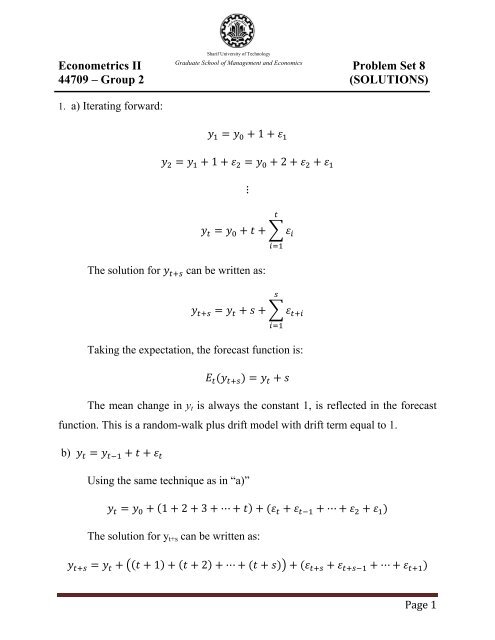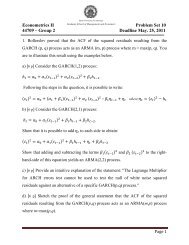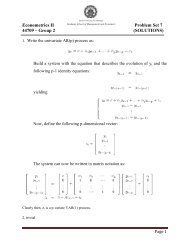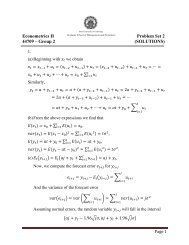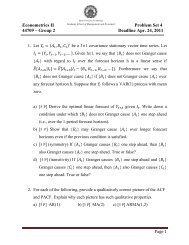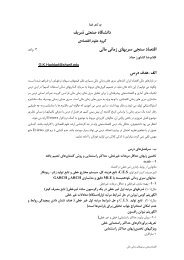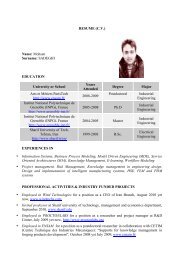Econometrics II Problem Set 8 44709 â Group 2 (SOLUTIONS)
Econometrics II Problem Set 8 44709 â Group 2 (SOLUTIONS)
Econometrics II Problem Set 8 44709 â Group 2 (SOLUTIONS)
You also want an ePaper? Increase the reach of your titles
YUMPU automatically turns print PDFs into web optimized ePapers that Google loves.
<strong>Econometrics</strong> <strong>II</strong><br />
Graduate School of Management and Economics<br />
<strong>Problem</strong> <strong>Set</strong> 8<br />
<strong>44709</strong> – <strong>Group</strong> 2 (<strong>SOLUTIONS</strong>)<br />
1. a) Iterating forward:<br />
Sharif University of Technology<br />
1 <br />
1 2 <br />
<br />
<br />
The solution for can be written as:<br />
<br />
<br />
<br />
<br />
Taking the expectation, the forecast function is:<br />
<br />
The mean change in y t is always the constant 1, is reflected in the forecast<br />
function. This is a random-walk plus drift model with drift term equal to 1.<br />
<br />
b) <br />
Using the same technique as in “a)”<br />
1 23 <br />
The solution for y t+s can be written as:<br />
1 2 <br />
Page 1
The forecast function is:<br />
1 2 <br />
1<br />
2<br />
Note that the change in y t is positively related to t. As such, the slope of the<br />
forecast function is positively related to t.<br />
c) Given initial conditions for all stochastic terms:<br />
In period zero, the value of is given by: 0.5 (assume that μ 0 ,<br />
η 0 and η -1 are known) so that we can write the model as:<br />
0.5 0.5 <br />
The solution for y t+s can be written as:<br />
<br />
<br />
0.5 0.5 <br />
Hence, the forecast function is:<br />
0.5 0.5 1<br />
0.5 1<br />
Here y t is a random-walk plus a stationary component that is a MA(1) process.<br />
<br />
<br />
Page 2
d) write as: Δy t = t + ε t . Now, simply detrend the Δy t sequence<br />
to obtain a stationary sequence.<br />
e) The model has an ARIMA(0,1,2) representation.<br />
Recall that: 0.5 where . Differencing once<br />
yields: 1 0.5 0.5 where is stationary.<br />
The { } sequence is stationary as:<br />
0,<br />
1.5 , and all autocorrelations are constant.<br />
The first order autocorrelation of is:<br />
, <br />
<br />
0.25 <br />
1.5<br />
<br />
The second order autocorrelation of is:<br />
, <br />
<br />
0.5 <br />
1.5<br />
<br />
The third order autocorrelation of is:<br />
, <br />
<br />
0<br />
1.5 0<br />
<br />
and: 0.<br />
Thus, the autocorrelation function of has the same characteristics as an MA(2)<br />
process, hence, has an ARIMA(0,1,2) representation.<br />
Page 3


